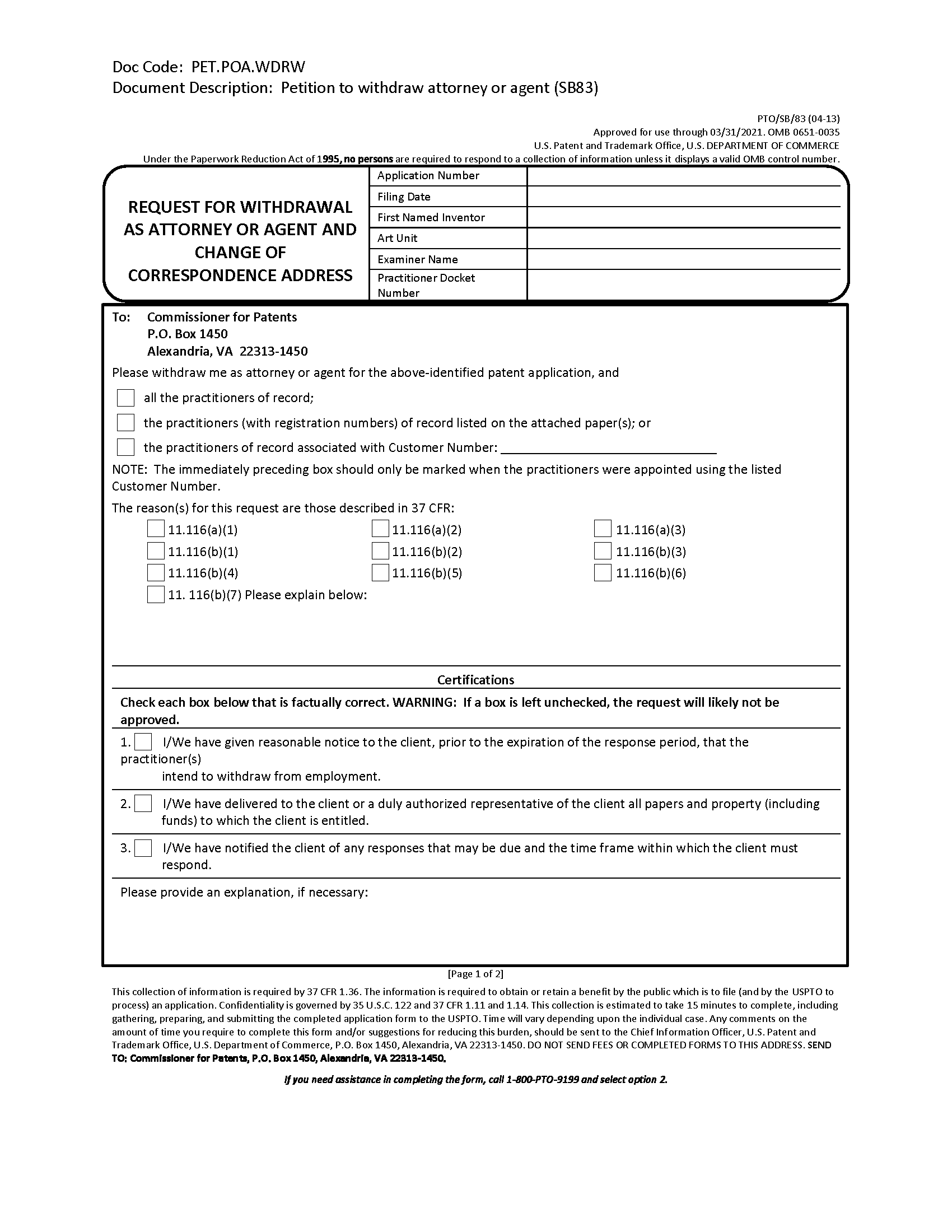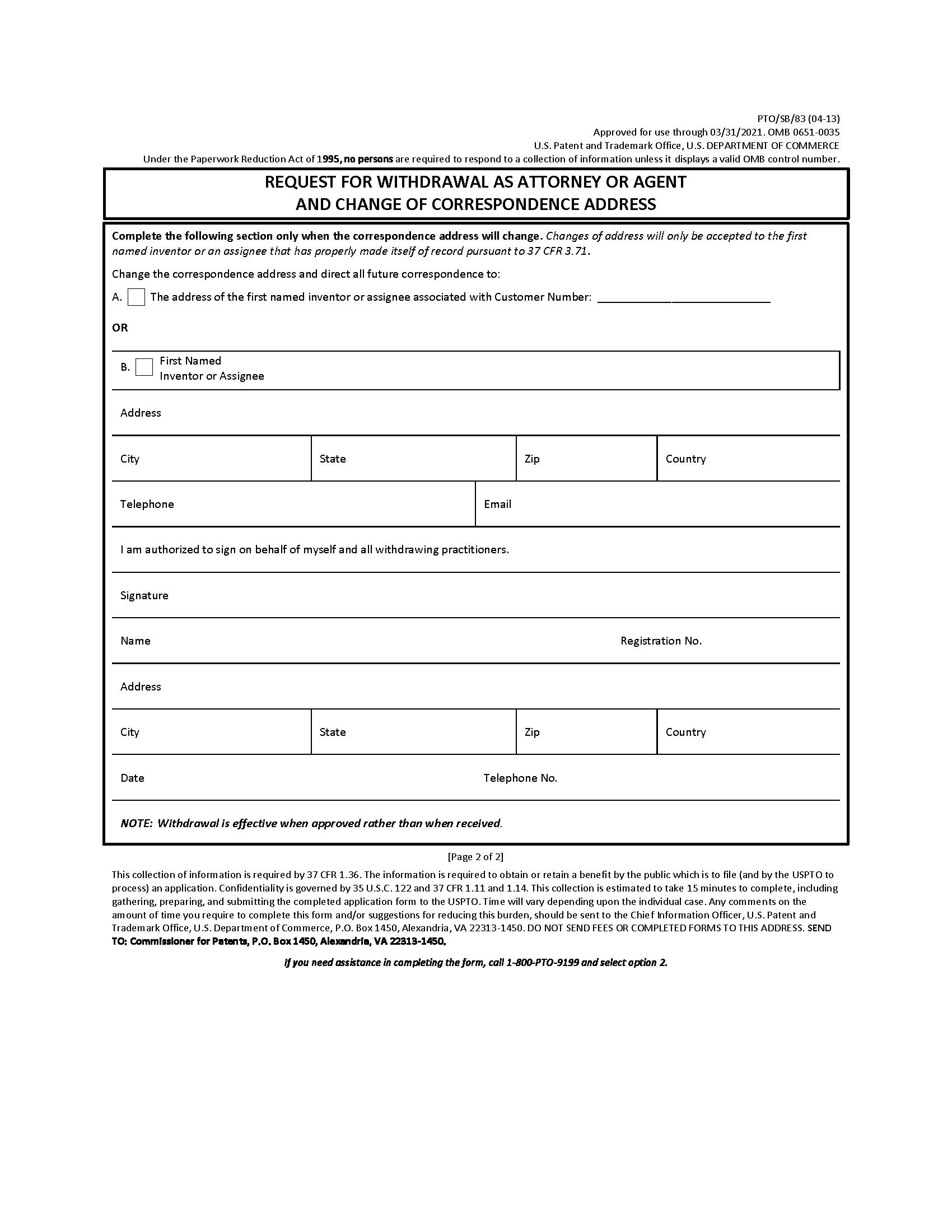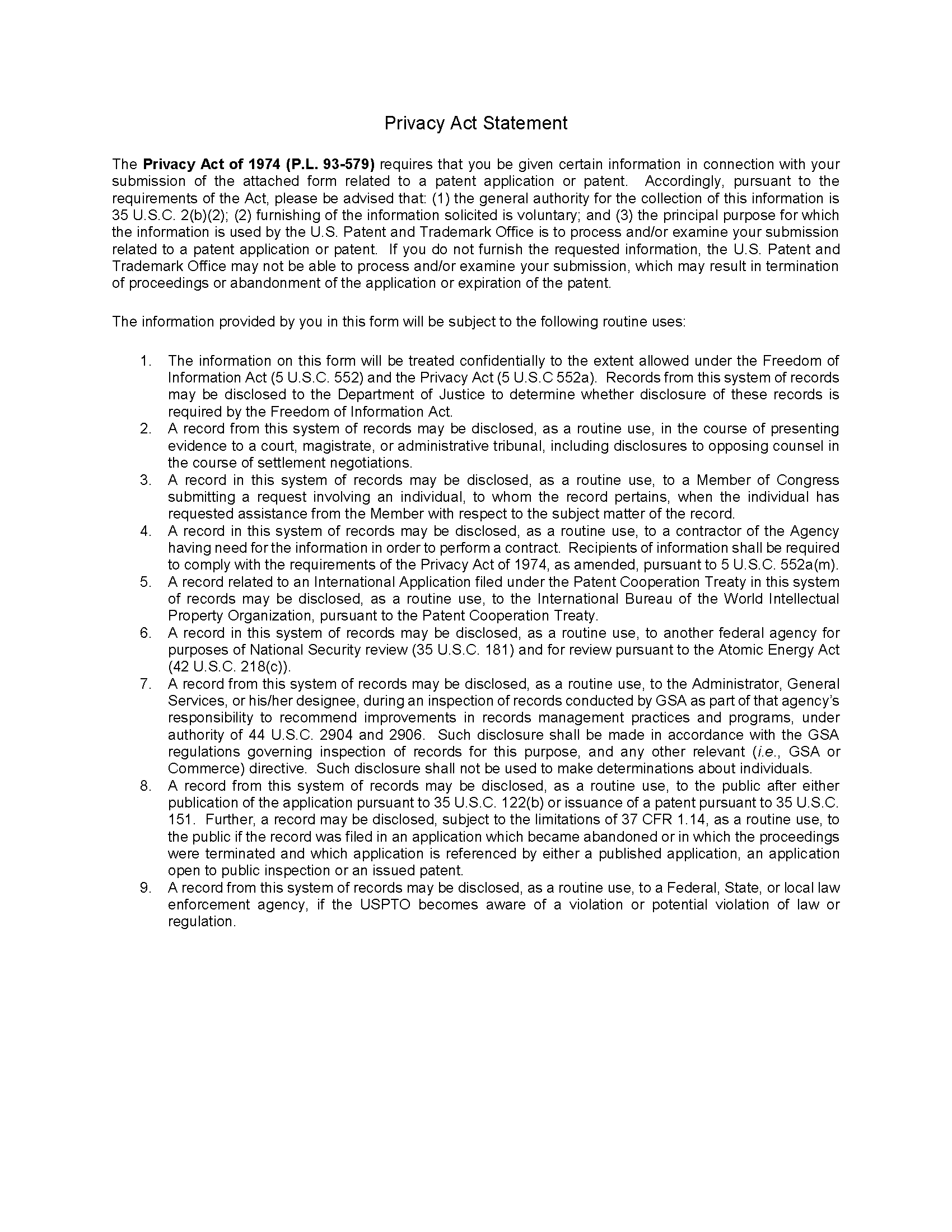The reexamination statute was amended on November 29, 1999 by the American Inventors Protection Act of 1999 (the AIPA), Public Law 106-113. The AIPA expanded reexamination by providing an " inter partes " option; it authorized the extension of reexamination proceedings via an optional inter partes reexamination procedure in addition to the existing ex parte reexamination procedure. See Title IV, subtitle F (§§ 4601 through 4608) of the "Intellectual Property and Communications Omnibus Reform Act of 1999," S. 1948 (106th Cong. 1st Sess. (1999)). Section 1000(a)(9), Division B, of Public Law 106-113 incorporated and enacted into law the "Intellectual Property and Communications Omnibus Reform Act of 1999" (S. 1948). As a result, new sections 311 -318 of title 35 United States Code directed to the optional inter partes reexamination proceeding were added by Public Law 106-113. The reexamination statute was again amended on November 2, 2002, by Public Law 107-273, 116 Stat. 1758, 1899-1906 (2002). Public Law 107-273 expanded the scope of what qualifies for a substantial new question of patentability upon which a reexamination may be based (see MPEP § 2642, POLICY IN SPECIFIC SITUATIONS, part A), expanded the third party requester’s appeal rights to include appeal to the U.S. Court of Appeals for the Federal Circuit (see MPEP § 2679), and made technical corrections to the statute. See the 21st Century Department of Justice Appropriations Authorization Act, TITLE III - INTELLECTUAL PROPERTY, Subtitle A - Patent and Trademark Office, Sections 13105 and 13106, of the "Patent and Trademark Office Authorization Act of 2002" - Enacted as part of Public Law 107-273 on November 2, 2002.
The present chapter is directed to inter partes reexamination procedure.
Upon enactment of the AIPA, 35 U.S.C. 312(a) provided, as to the standard for granting an inter partes reexamination request, that "the Director shall determine whether a substantial new question of patentability affecting any claim of the patent concerned is raised by the request, with or without consideration of other patents or printed publications…." The Office has referred to this standard as "SNQ."
The Leahy-Smith America Invents Act (the AIA), Public Law 112-29, 125 Stat. 284, was enacted September 16, 2011. Section 6(c) of the AIA replaced the inter partes reexamination process, effective September 16, 2012, with a new inter partes review process, such that on or after September 16, 2012 the Office no longer entertains requests for inter partes reexamination but instead accepts petitions to conduct inter partes review. For any inter partes reexamination filed prior to September 16, 2012, the provisions of 35 U.S.C. 311 – 35 U.S.C. 318 as they were in effect prior to September 16, 2012, continue to apply to the inter partes reexamination proceedings.
Section 6(c)(3)(B) of the AIA provided a one year transition period (from inter partes reexamination to inter partes review) beginning September 16, 2011 and ending September 15, 2012, during which inter partes reexamination filings would continue to be accepted, but the standard for granting an inter partes reexamination request was revised to require, pursuant to 35 U.S.C. 312, that the information presented in a request for inter partes reexamination must show that there is a reasonable likelihood that the requester will prevail with respect to at least one of the claims challenged in the request.
As a result of the enactment of section 6(c) of the AIA, the following applies for inter partes reexamination:
For a patent issued from an application filed prior to November 29, 1999, the statutory inter partes reexamination option is not available, only the ex parte reexamination is available as a reexamination option (see 37 CFR, Sub-part D, 37 CFR 1.510 et seq.).
All citations in this chapter to 35 U.S.C. Chapter 31 (i.e., 35 U.S.C. 311-318) are to the relevant statute in effect for inter partes reexamination prior to September 16, 2012.
See MPEP Chapter 2200 (§ 2209 et seq.) for guidance on the procedures for ex parte reexamination proceedings.
The flowcharts show the general flow for the various stages of inter partes reexamination proceedings. The first flowchart shows the procedures before appeal for a reexamination filed prior to September 16, 2011 (e.g., under the SNQ standard). Except for the standard for instituting reexamination, the same procedure pertains for an inter partes reexamination filed from September 16, 2011 through September 15, 2012. The second flowchart shows the appeal procedure with a single third party requester. The third flowchart shows the procedures following a Board decision for reexamination proceedings commenced prior to November 2, 2002. The fourth flowchart shows the procedures following a Board decision for reexamination proceedings commenced on or after November 2, 2002.
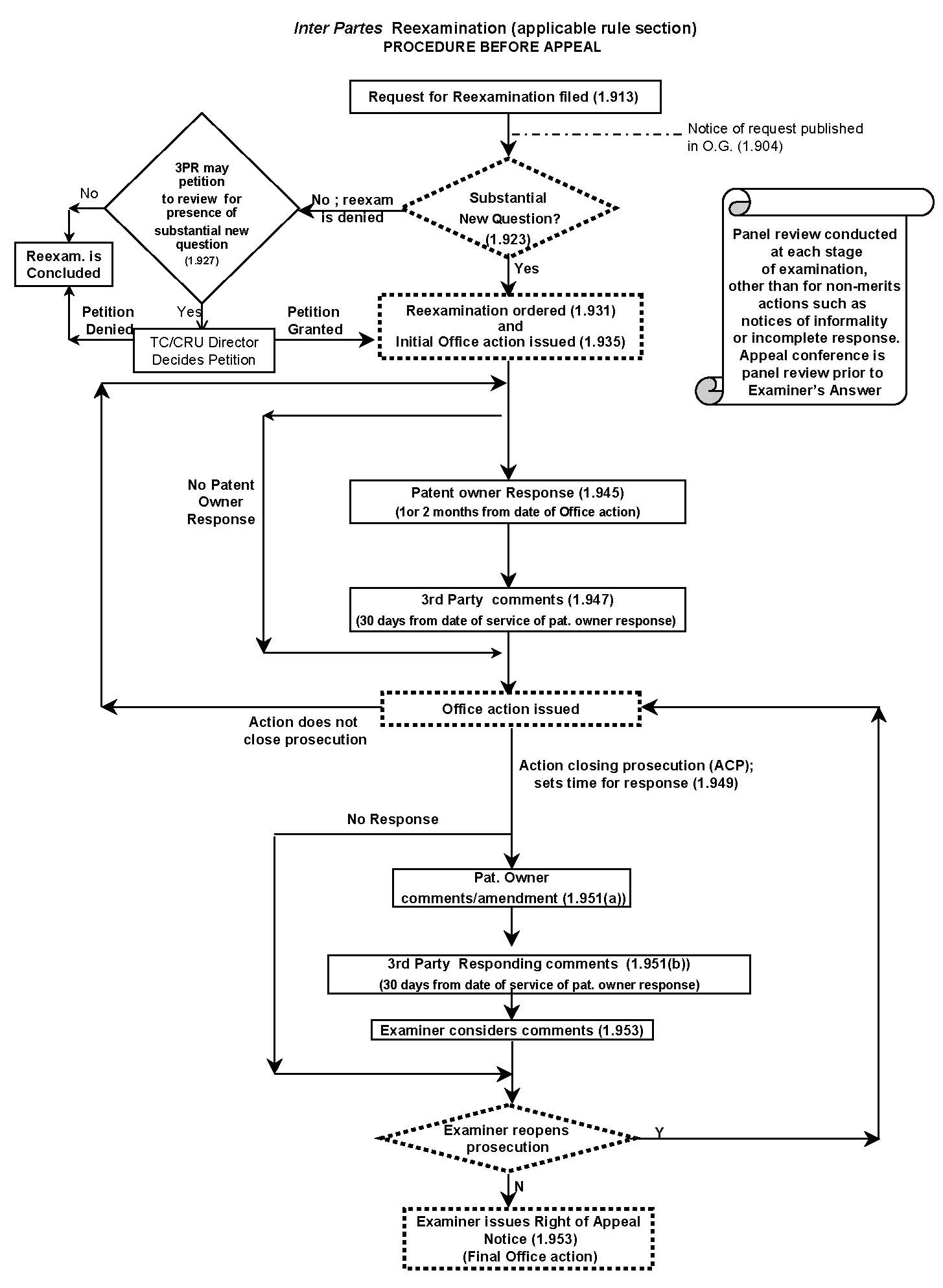
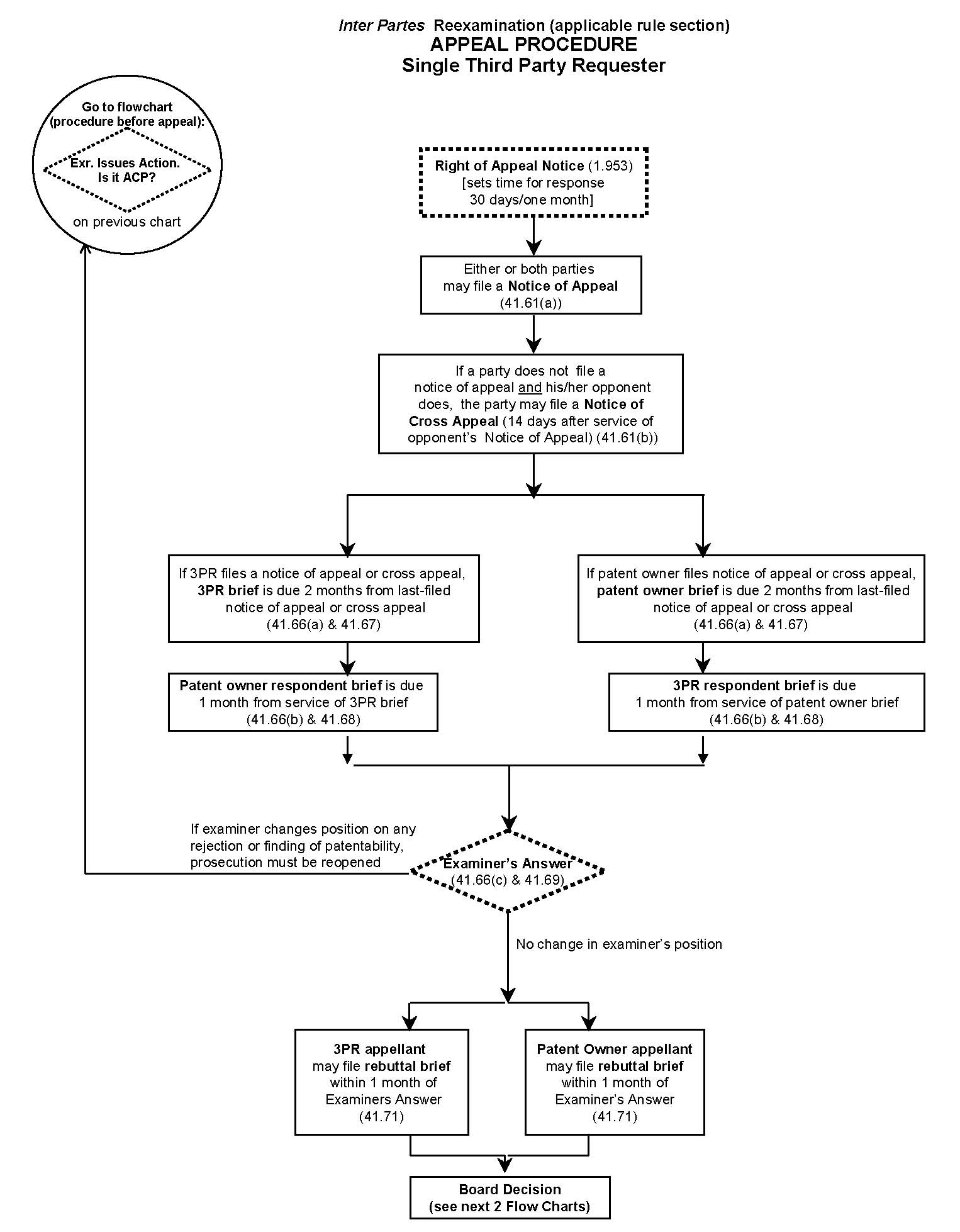
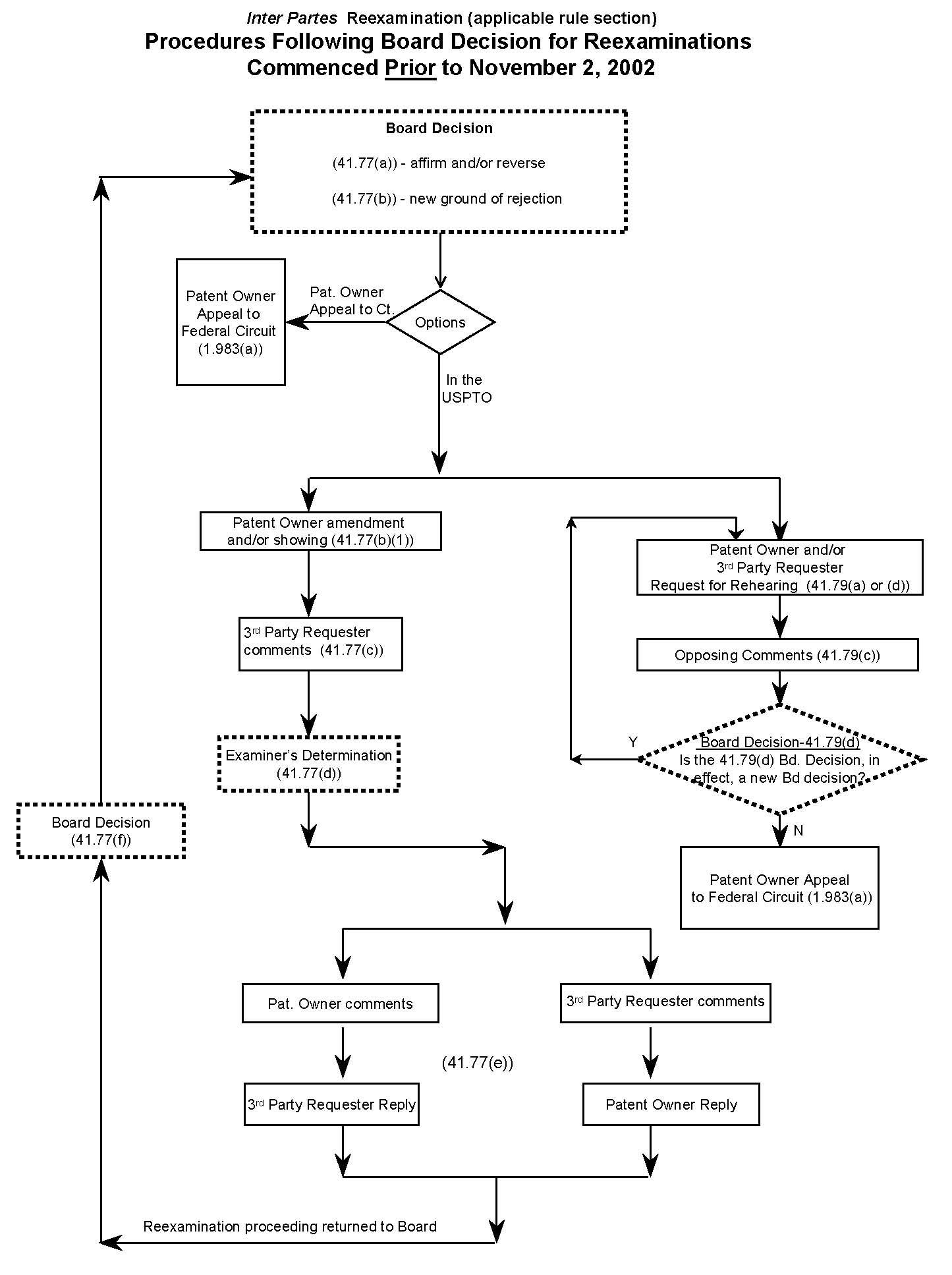
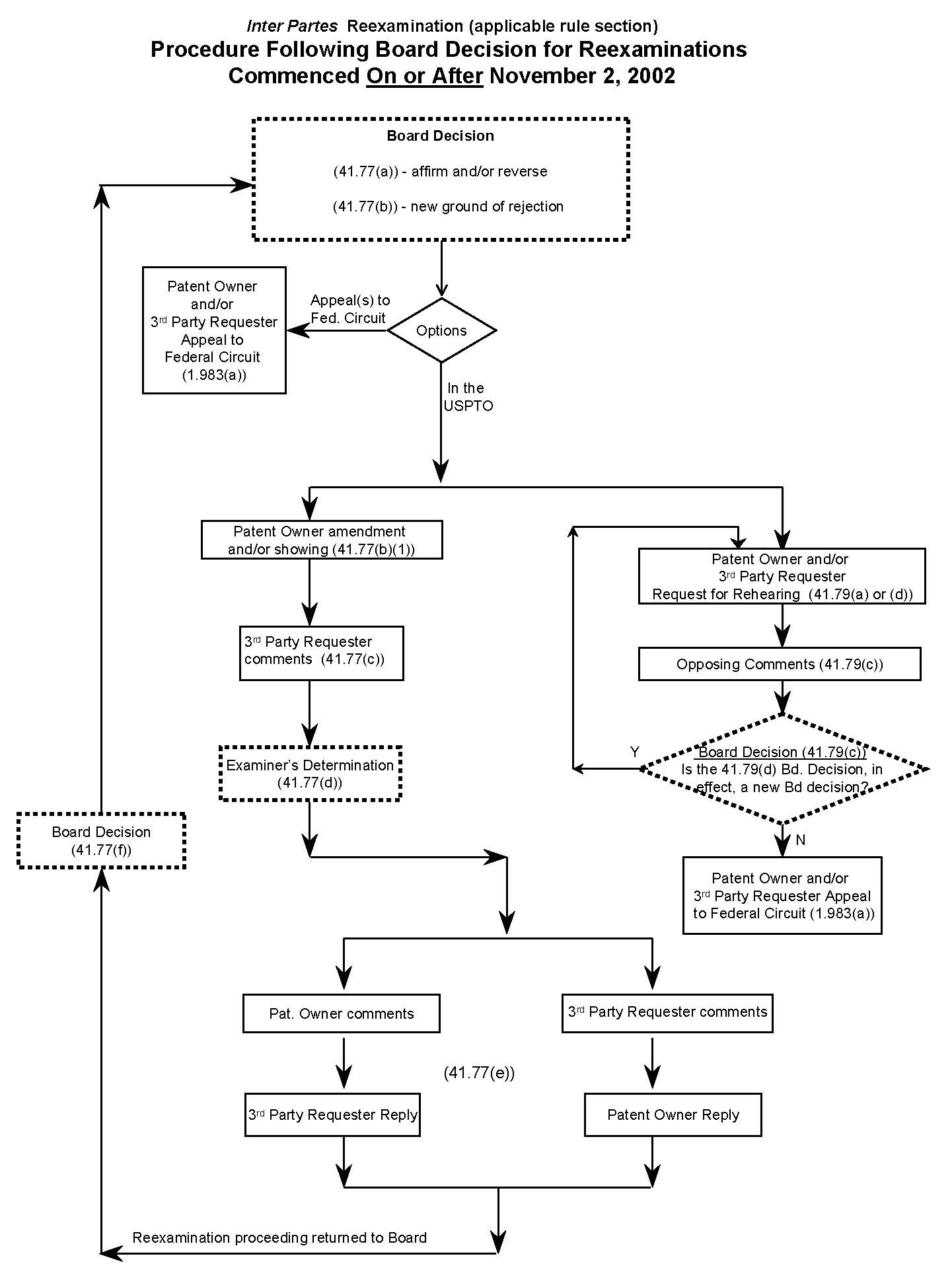
Citations by the patent owner in accordance with § 1.933 and by an inter partes reexamination third party requester under § 1.915 or § 1.948 will be entered in the inter partes reexamination file. The entry in the patent file of other citations submitted after the date of an order for reexamination pursuant to § 1.931 by persons other than the patent owner, or the third party requester under either § 1.913 or § 1.948, will be delayed until the inter partes reexamination proceeding has been concluded by the issuance and publication of a reexamination certificate. See § 1.502 for processing of prior art citations in patent and reexamination files during an ex parte reexamination proceeding filed under § 1.510.
American Inventors Protection Act of 1999 (the AIPA) did not affect the manner of the public’s citation of prior art under 37 CFR 1.501 in a patent. Likewise, it did not affect the Office’s handling of a 37 CFR 1.501 prior art citation in a patent where no reexamination proceeding is pending for that patent when the citation is filed.
Where an inter partes reexamination proceeding is pending when a prior art citation is filed, the following applies:
If the prior art citation satisfies 37 CFR 1.501 and was submitted prior to an order for reexamination, the cited documents (citations) will be considered in an inter partes reexamination proceeding as a prior art citation would be considered in an ex parte reexamination proceeding. See MPEP § 2206.
If the prior art citation satisfies 37 CFR 1.501 and is submitted after an order for reexamination, the citation will be treated as follows:
The Leahy-Smith America Invents Act (the AIA), Public Law 112-29, 125 Stat. 284, enacted September 16, 2011, provided, under 35 U.S.C. 301(a)(2) for submission of "statements of the patent owner filed in a proceeding before a federal court or the Office in which the patent owner took a position on the scope of any claim of a particular patent"; however, there is no provision of the statute that applies a submission under 35 U.S.C. 301(a)(2) to an ongoing inter partes reexamination. Thus, a submission under 35 U.S.C. 301(a)(2) is not proper for an inter partes reexamination.
See MPEP §§ 2202 through 2206 and 2208 for the manner of making such citations and Office handling of same.
The inter partes reexamination statute and rules permit any third party requester to request, prior to September 16, 2012, inter partes reexamination of a patent which issued from an original application filed on or after November 29, 1999, where the request contains certain elements (see 37 CFR 1.915(b) ) and is accompanied by the fee required under 37 CFR 1.20(c)(2). The Office initially determines whether the standard for granting reexamination (see 35 U.S.C. 312(a) ) is met. If yes, reexamination will be ordered. The reexamination proceedings which follow the order for reexamination are somewhat similar to regular examination procedures in patent applications; however, there are notable differences. For example, there are certain limitations as to the kind of rejections which may be made, a third party requester may participate throughout the proceeding, there is an "action closing prosecution" and a "right of appeal notice" rather than a final rejection, special reexamination forms are to be used, and time periods are set to provide "special dispatch." When the prosecution of an inter partes reexamination proceeding is terminated, an inter partes reexamination certificate is issued to indicate the status of all claims following the reexamination and concludes the reexamination proceeding.
The basic characteristics of inter partes reexamination are as follows:
Patent owners and third party requesters are cautioned that the reexamination statute, regulations, and published examining procedures do not countenance so-called "litigation tactics" in reexamination proceedings. The parties are expected to conduct themselves accordingly. For example, it is expected that submissions of papers that are not provided for in the reexamination regulations and/or appear to be excluded by the regulation will either be filed with an appropriate petition to accept the paper and/or waive the regulation(s), or not filed at all. Parties are advised that multiple submissions, such as a reply to a paper opposing a petition and a sur-reply directed to such a reply are not provided for in the regulations or examining procedures governing inter partes reexamination. It is expected that the parties will adhere to the provisions of 37 CFR 11.18(b) throughout the course of a reexamination proceeding.
No requests for inter partes reexamination may be filed on or after September 16, 2012. Guidance on the former practice is available in revision 7 of the 8th Edition of the MPEP and in Revision of Standard for Granting an Inter Partes Reexamination Request, 76 FR 59055 (September 23, 2011).
No requests for inter partes reexamination may be filed on or after September 16, 2012. Guidance on the former practice is available in revision 7 of the 8th Edition of the MPEP and in Revision of Standard for Granting an Inter Partes Reexamination Request, 76 FR 59055 (September 23, 2011).
No requests for inter partes reexamination may be filed on or after September 16, 2012. Guidance on the former practice is available in revision 7 of the 8th Edition of the MPEP and in Revision of Standard for Granting an Inter Partes Reexamination Request, 76 FR 59055 (September 23, 2011).
*****
*****
Where an attorney or agent files a request for an inter partes reexamination for an identified client (the third party requester), he or she may act under a power of attorney from the client or may act in a representative capacity under 37 CFR 1.34 . See 37 CFR 1.915(c). While the filing of the power of attorney is desirable, processing of the reexamination request will not be delayed due to its absence.
In order to act in a representative capacity under 37 CFR 1.34, an attorney or agent must set forth his or her registration number, name, and signature. In order to act under a power of attorney from a requester, an attorney or agent must be provided with a power of attorney. 37 CFR 1.32(c) provides that a "power of attorney may only name as representative" the inventors or registered patent practitioners. Thus, an attorney or agent representing a requester must be a registered patent practitioner.
If any question of authority to act is raised, proof of authority may be required by the Office.
All correspondence for a third party requester is addressed to the representative of the requester, unless a specific indication is made to forward correspondence to another address.
A third party requester may not be represented during a reexamination proceeding by an attorney or other person who is not registered to practice before the Office.
No requests for inter partes reexamination may be filed on or after September 16, 2012. Guidance on the former practice is available in revision 7 of the 8th Edition of the MPEP and in Revision of Standard for Granting an Inter Partes Reexamination Request, 76 FR 59055 (September 23, 2011).
No requests for inter partes reexamination may be filed on or after September 16, 2012. Guidance on the former practice is available in revision 7 of the 8th Edition of the MPEP and in Revision of Standard for Granting an Inter Partes Reexamination Request, 76 FR 59055 (September 23, 2011).
No requests for inter partes reexamination may be filed on or after September 16, 2012. Guidance on the former practice is available in revision 7 of the 8th Edition of the MPEP and in Revision of Standard for Granting an Inter Partes Reexamination Request, 76 FR 59055 (September 23, 2011).
No requests for inter partes reexamination may be filed on or after September 16, 2012. Guidance on the former practice is available in revision 7 of the 8th Edition of the MPEP and in Revision of Standard for Granting an Inter Partes Reexamination Request, 76 FR 59055 (September 23, 2011).
No requests for inter partes reexamination may be filed on or after September 16, 2012. Guidance on the former practice is available in revision 7 of the 8th Edition of the MPEP and in Revision of Standard for Granting an Inter Partes Reexamination Request, 76 FR 59055 (September 23, 2011).
No requests for inter partes reexamination may be filed on or after September 16, 2012. Guidance on the former practice is available in revision 7 of the 8th Edition of the MPEP and in Revision of Standard for Granting an Inter Partes Reexamination Request, 76 FR 59055 (September 23, 2011).
No requests for inter partes reexamination may be filed on or after September 16, 2012. Guidance on the former practice is available in revision 7 of the 8th Edition of the MPEP and in Revision of Standard for Granting an Inter Partes Reexamination Request, 76 FR 59055 (September 23, 2011).
*****
*****
Address of Patent Owner: The correspondence address for the patent to be reexamined, or being reexamined is the correct address for all notices, official letters, and other communications for patent owners in reexamination proceedings. See 37 CFR 1.33(c).
Representative of Patent Owner: As a general rule, the attorney-client relationship terminates when the purpose for which the attorney was employed is accomplished; e.g., the issuance of a patent to the client. However, under 37 CFR 11.104, as under former 37 CFR 10.23(c)(8), a practitioner should not fail to timely and adequately inform a client or former client of correspondence received from the Office in a proceeding before the Office or from the client’s or former client’s opponent in an inter partes proceeding before the Office when the correspondence (i) could have a significant effect on a matter pending before the Office, (ii) is received by the practitioner on behalf of a client or former client, and (iii) is correspondence of which a reasonable practitioner would believe under the circumstances the client or former client should be notified. This responsibility of a practitioner to a former client is not eliminated by withdrawing as an attorney or agent of record. See also 37 CFR 1.116(d). The practitioner if he/she so desires, can minimize the need for forwarding correspondence concerning issued patents by having the correspondence address changed after the patent issues if the correspondence address is the practitioner’s address, which frequently is the case where the practitioner is the attorney or agent of record.
If the patent owner desires that a different attorney or agent receive correspondence, then a new power of attorney must be filed. See MPEP § 324 for establishing an assignee’s right to take action when submitting a power of attorney in applications filed before September 16, 2012.
Submissions to the Office to change the correspondence address or power of attorney in the record of the patent should be addressed as follows:
Where a request for inter partes reexamination has been filed and a reexamination proceeding is accordingly pending as to a patent.
Mail Stop "Inter Partes Reexam"
Attn: Central Reexamination Unit
Commissioner for Patents
P.O. Box 1450
Alexandria, VA 22313-1450
Where no request for reexamination has been filed and the patent is in storage:
Mail Stop Document Services
Director of the U.S. Patent and Trademark Office
P.O. Box 1450
Alexandria, VA 22313-1450
It is strongly recommended that the Mail Stop information be placed in a prominent position on the first page of each paper being filed utilizing a sufficiently large font size that will direct attention to it.
Sample forms for changing correspondence address or power of attorney for the patent owner, and for the third party requester are set forth below.
Form PTO/AIA/81B Reexamination or Supplemental Examination – Patent Owner Power of Attorney or Revocation of Power of Attorney with a New Power of Attorney and Change of Correspondence Address for Reexamination or Supplemental Examination and Patent
Form PTO/SB/81C Reexamination – Third Party Requester Power of Attorney or Revocation of Power of Attorney with a New Power of Attorney and Change of Correspondence Address
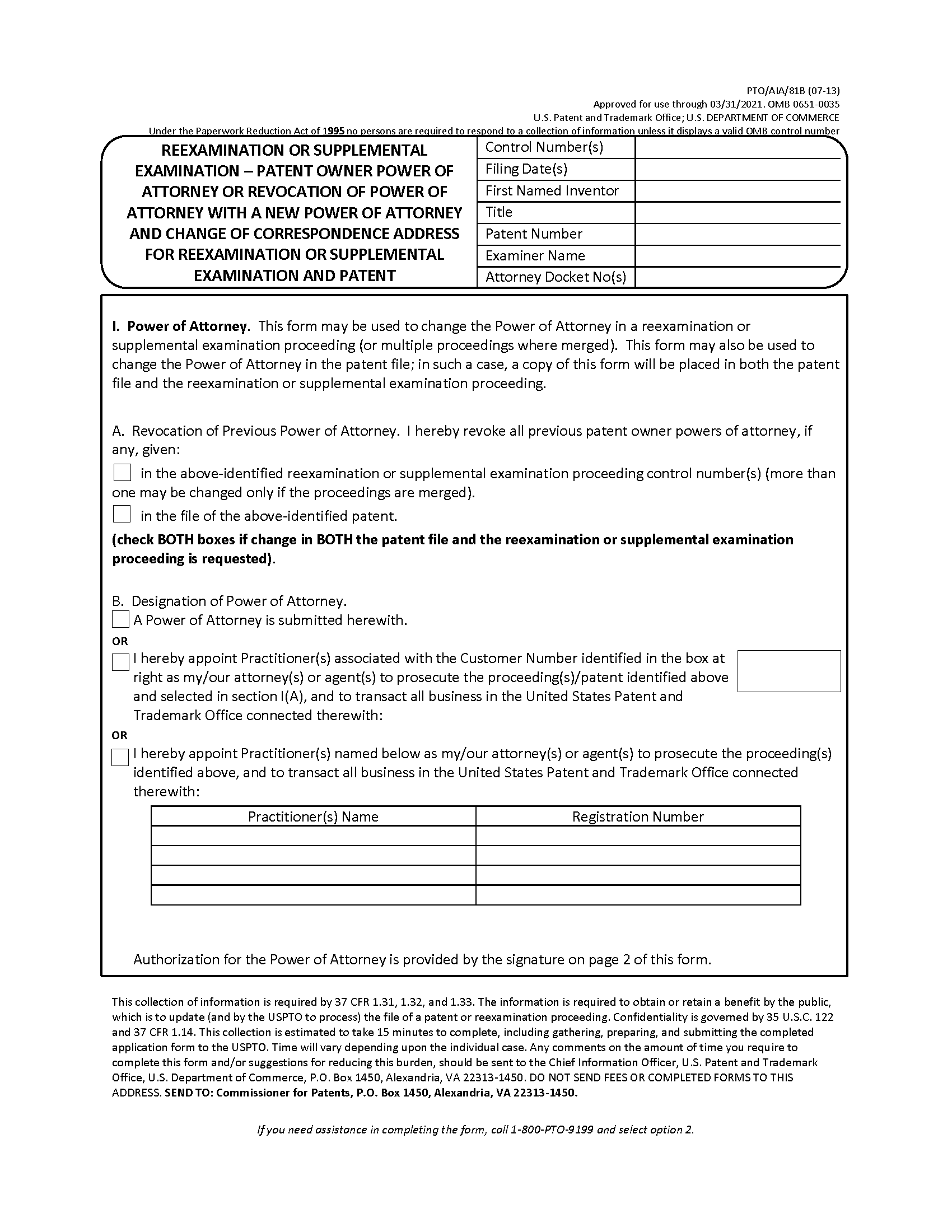
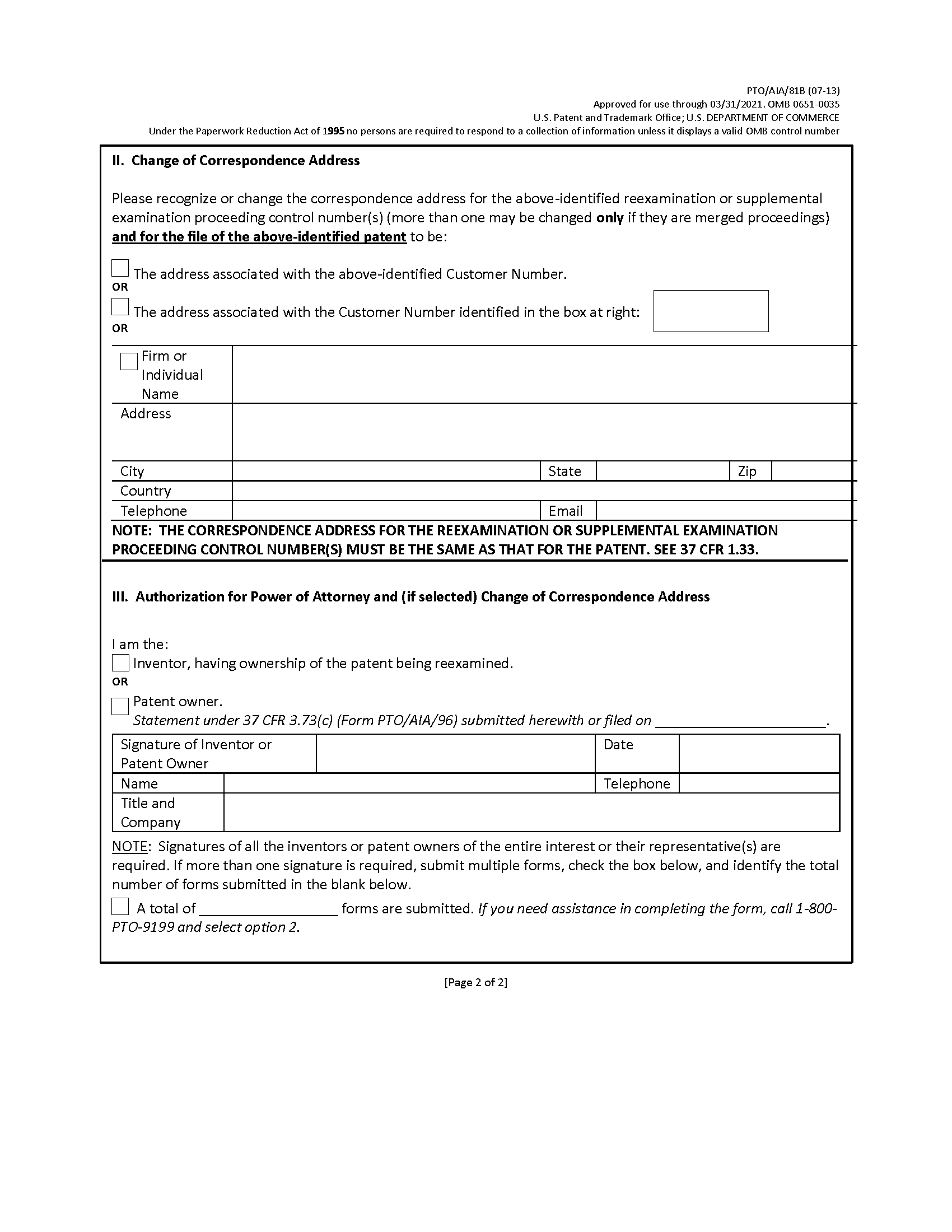
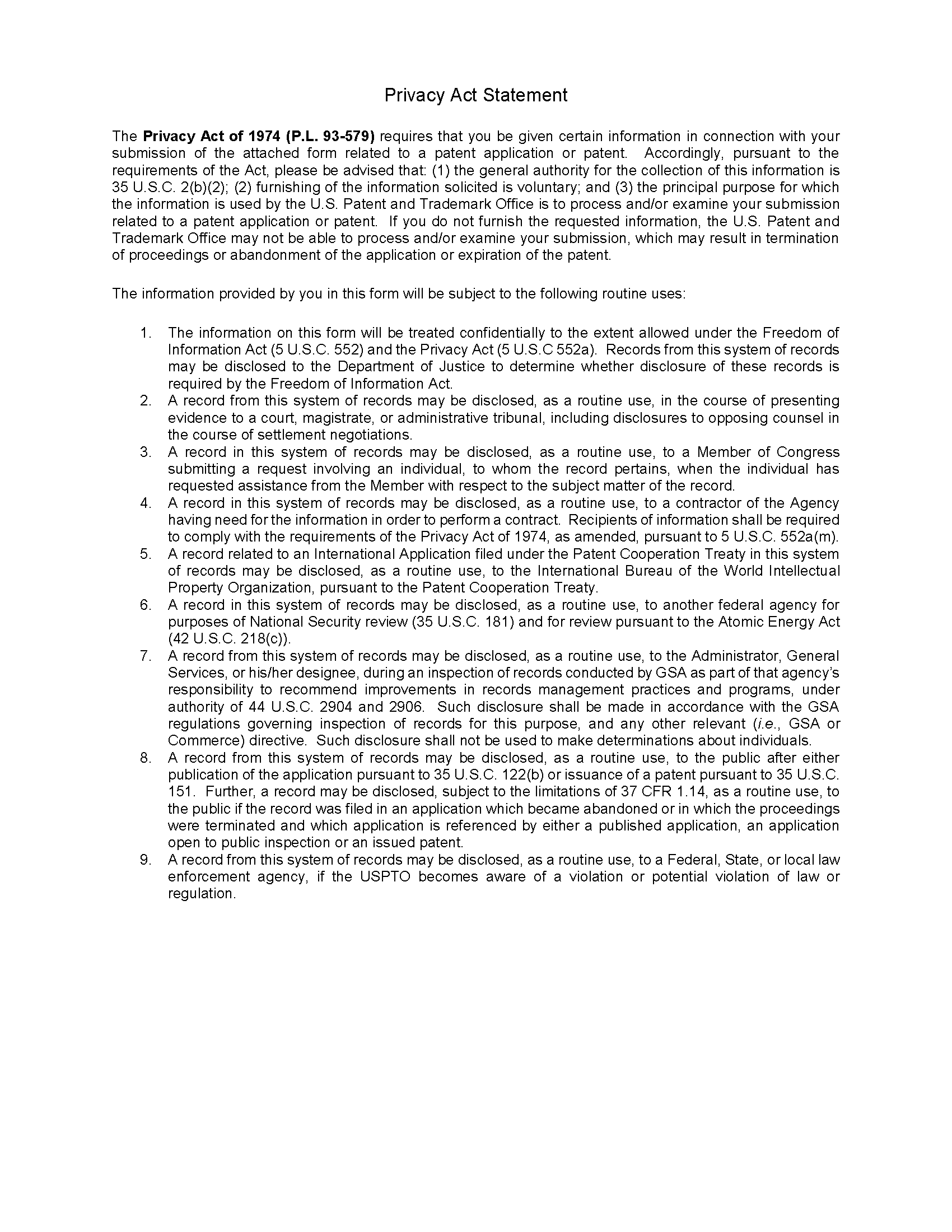
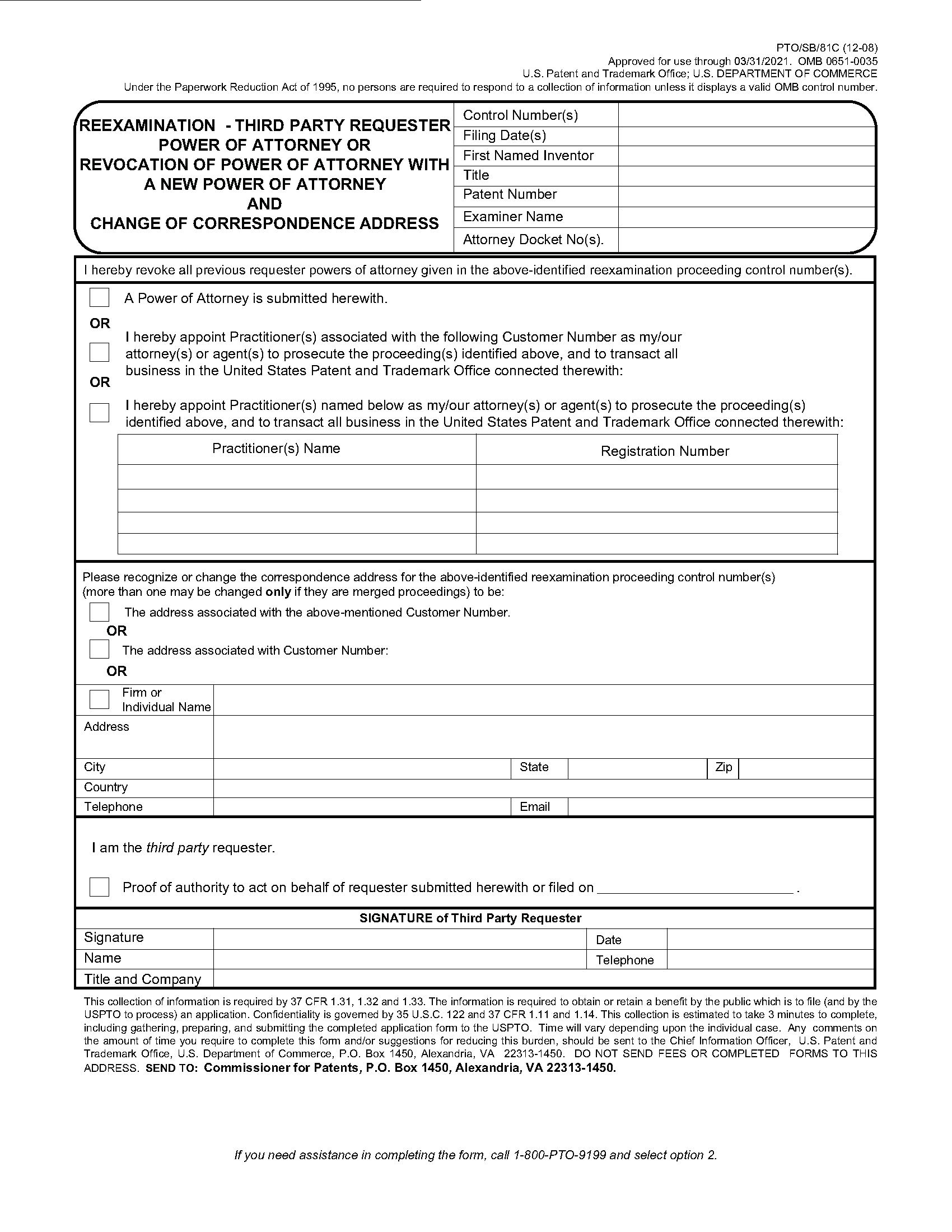
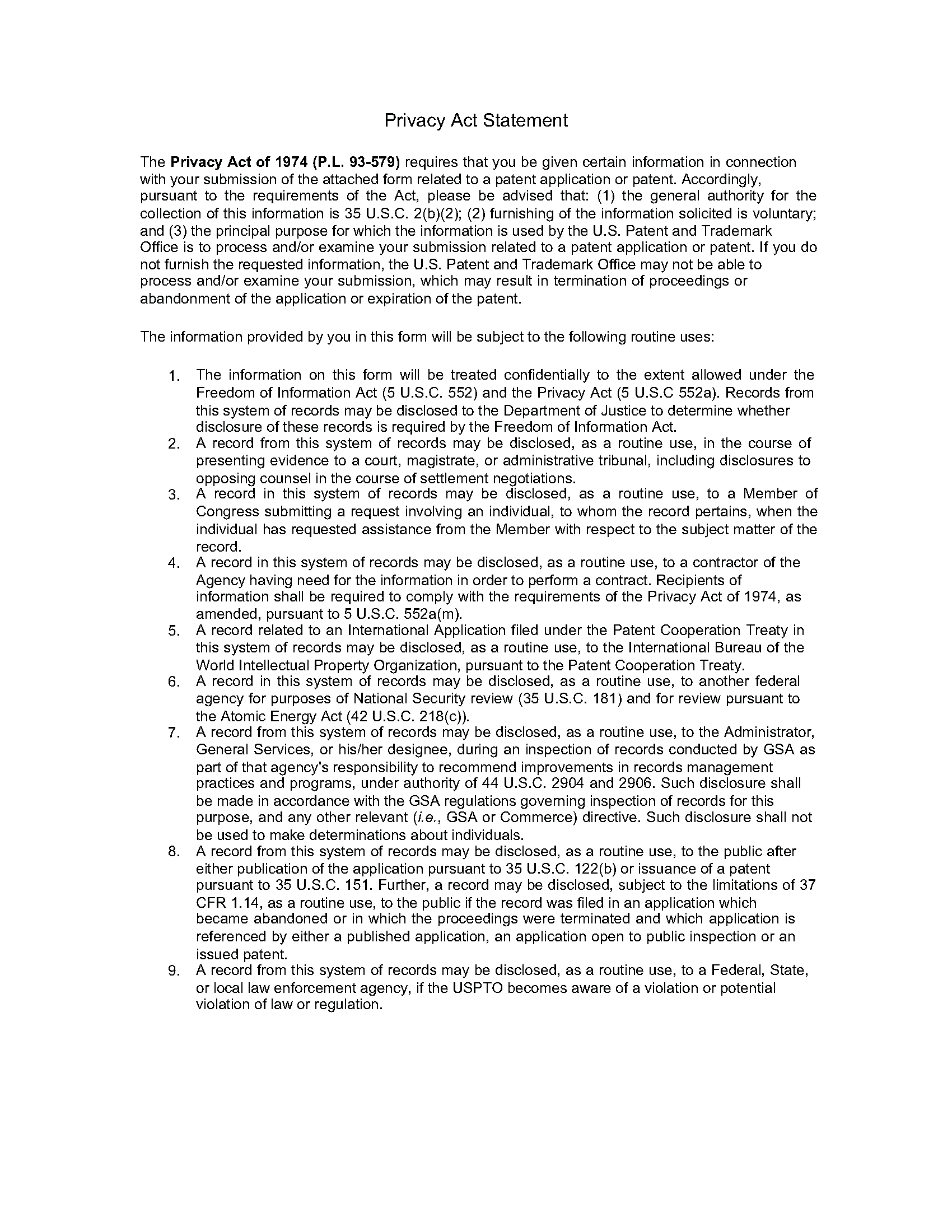
For a practitioner to withdraw from a patent and/or reexamination proceeding, the Office no longer requires that there be at least 30 days remaining in any running period for response between the approval of a request to withdraw from representation and the expiration date of any running period for response. Instead, pursuant to 37 CFR 11.116, the Office requires the practitioner(s) to certify that he, she or they have: (1) given reasonable notice to the client, prior to the expiration of the response period, that the practitioner(s) intends to withdraw from employment; (2) delivered to the client or a duly authorized representative of the client all papers and property (including funds) to which the client is entitled; and (3) notified the client of any responses that may be due and the time frame within which the client must respond. "Reasonable notice" would allow a reasonable amount of time for the client to seek the services of another practitioner prior to the expiration of any applicable response period. See also MPEP § 402.06.
A sample form for a request by an attorney or agent of record to withdraw from a patent is set forth below.
